Homeschooling is not school at home. In this video, I describe some of the differences between homeschooling and institutional public/private schools.
First in a series: Language Arts
My husband recently “babysat” a friend’s nine year old while the latter participated in his online public school classes. My husband came home that evening and looked at me. “Have you listened to what goes on in those classes?” he asked.
Why, yes. And it vindicates my decision, lo these many years ago, to homeschool my children. Not all schools are the same and certainly teachers now are valiantly trying to impart education under trying circumstances.
However.
Listening – or even more – helping students to complete their online assignments has clarified the differences between how I want to teach children and the “norm.” These thoughts are on education at the elementary school level.
What Happened to Literature?
Charlotte Mason had a word she used for poor quality reading material for children: twaddle. Children should read both for pleasure and information, but giving them twaddle to read does not promote a literate child. Reading is not only a source of pleasure and information. It is also how one acquires language, a sense of grammar and spelling, as well as an innate sense of poetry – the beauty of language both for the ideas it conveys and the manner in which the ideas are expressed. These are acquired as one reads. Reading twaddle encourages sloppy grammar and a childish sense of how to express oneself in the written word.
At Samson, third and fourth grade students as a group read books such as Rascal and My Side of the Mountain and have access to the free reading bookshelf containing books such as Little House on the Prairie, Alice in Wonderland, and Wind in the Willows. In addition to these and other classics, Caldecott award winners are another good source of children’s better literature.
What’s Going on with Writing?
I agree with Charlotte Mason that children must be taught to organize their thoughts through oral narration before being asked to express themselves through writing. I am especially frustrated by insistence that young children write in particular styles of composition: expository, persuasive, etc. Children under the age of 9 learn the mechanics of writing (and absorb grammar and spelling) through copywork: copying sayings, poems, or excerpts from literature. They learn to organize their thoughts by narrating to the teacher what they have read or heard the teacher (or other student) read to them.
Starting at about age 10, children use written narration to narrate back to the teacher the same kinds of information. In this way, writing (composition) is not a separate subject in itself, but integrated with other subjects such as history or literature. Styles of writing (expository, etc.) are introduced at the middle school or even high school level, not elementary school.
| A Side Note About Fine Motor Coordination In addition to handwriting skills such as printing and cursive, I also teach handicraft skills such as weaving, knitting, and playing the recorder. Particularly for boys, I see a correlation between a reluctance to write and difficulty forming letters. Activities such as these are a useful – and fun! – adjunct to copywork and Handwriting Without Tears workbooks to strengthen hand muscles and develop fine motor control. |
What Happened to Grammar?
All this talk about “naturally absorbing” language is not to say we do not study the rules of sentence construction, also known as grammar. However, at the lower elementary levels grammar is not presented in separate lessons but part of copywork and reading. Starting at third grade, students have (short) formal grammar lessons three times a week using The Well-Trained Mind worksheets. Students are taught the parts of speech and are introduced to sentence diagramming. An understanding of grammar produces clear writing and a foundation for the study of foreign languages.
What Happened to Spelling?
Granted my experience is limited to just two schools, but I have yet to see spelling taught in any of the online classes I observe. In my pod school, we do daily exercises in sight words AND daily worksheets on spelling words of the week. Our sight word exercises – writing in the air, visualizing the word in our minds, writing in the palm of our hand, spelling out loud – not only address different types of learning, but serve as models for retaining information which will prove useful in upper grades and higher education. For workbooks, we use Spelling Workout, which is phonics-based. Upper levels focus on vocabulary and word origins. (Starting in the 4th grade, students also complete Vocabulary from Classical Roots workbooks.)
A Firm Foundation
Education at the elementary level should provide a firm foundation for more advanced material. Children who do not get a solid grounding in basic language skills will have difficulty in upper level instruction. While many children do well in public schools, those who need extra time – or more accelerated work – will benefit from the individual attention afforded by home education or a pod school. These kinds of environments also give us the opportunity to consider how the material should be taught. Material and mechanisms chosen for logistical, or political, reasons in a setting of 25 children or more do not necessarily apply in the micro-sized classroom. For parents to have true freedom of choice, they must be aware of their options. The above describes other, time-tested, methods of education.
My previous post having mysteriously disappeared, I am reposting my description of a sample day when HISD is not in session but Samson Home School Academy is.
Although HISD was closed the week of Thanksgiving, Samson Home School Academy held classes Monday and Tuesday. Since there were no online classes, we had a more flexible schedule. The following is how the 3rd and 4th grade classroom spent the last day before Thanksgiving vacation.
We started the day with a short session of aerobics, followed by a several yoga poses and breathing exercises. Then students settled into their places to do some drawing exercises while listening to Mozart, the composer of the month. The drawing exercises serve to not only create quiet focus but to teach the student how to “see” shapes and their relationship to surrounding space. In addition, for one or two students, it was practice in fine motor control.
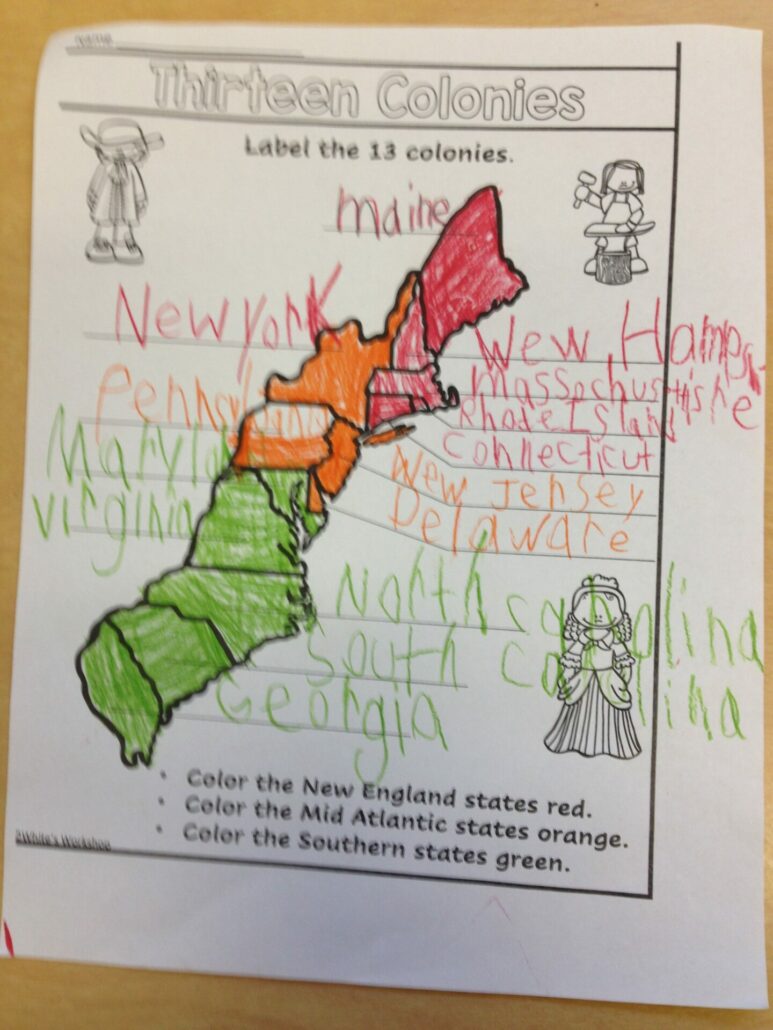
Following our drawing session, we labeled a map of the 13 colonies and discussed the different populations who immigrated to the New Land. This discussion included differences between those who came seeking religious freedom (with some background on the Reformation and the religious conflicts of 16th and 17th century Europe) and those who came for economic reasons. We also discussed the geographical differences between the colonies and how this influenced their economies.
Students then brought their looms to the carpet to weave while watching a portion of The 1940s House, a BBC program about life in London during WWII. The students had expressed an interest in the subject after learning about Winston Churchill in an earlier biography-of-the-week lesson.
Given the nice weather, we then moved outdoors where we set up stools and a nature table. We gathered leaves and acorns to create a still life on the nature table. We discussed perspective and learning to draw what the eye sees rather than an idea of what an object looks like. After a short sketching session, we grabbed our lunches and ate outdoors.
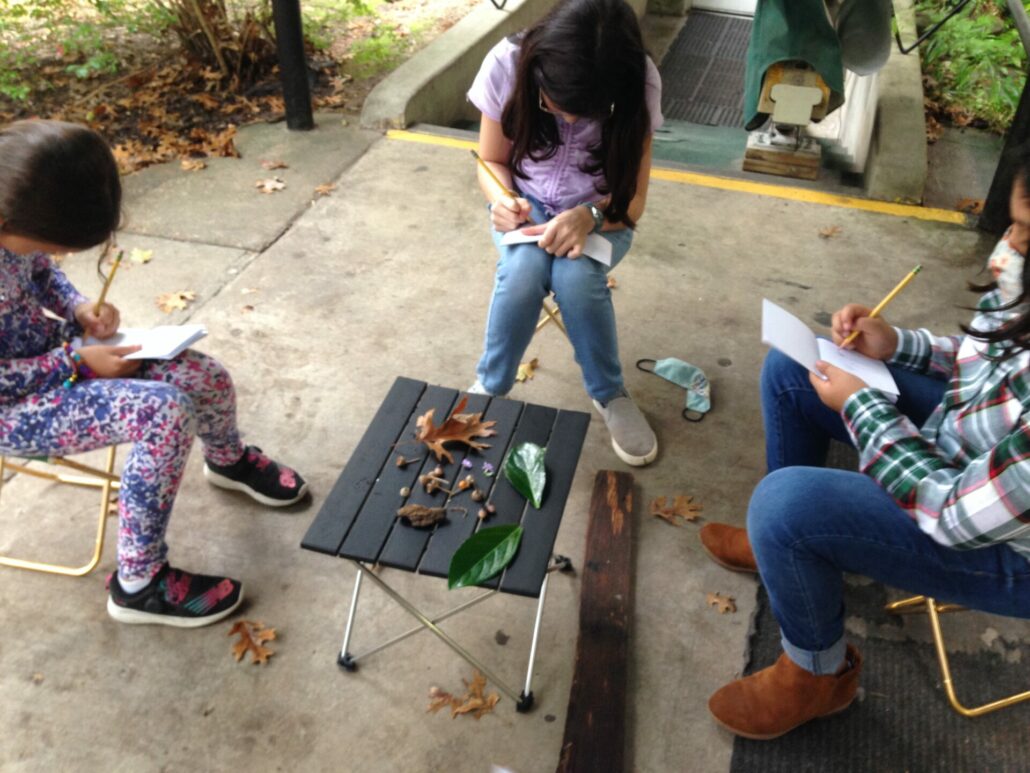
After lunch, we returned to the classroom to do skip counting songs followed by timed multiplication drill sheets. We then watched a video describing the Boston Tea Party. Afterward, we discussed the growing tension between the colonists and the King and Parliament of England.
The rest of the day was spent on a basket weaving project (more fine motor control training) and watching the rest of the first episode of 1940s House. The previous day we had discussed everyday life in colonial America. The students were struck by the differences between colonial America, present day America, and wartime London.
To finish the day, students divided up the chores and cleaned the classroom before packing backpacks and heading for the gate to await parents.
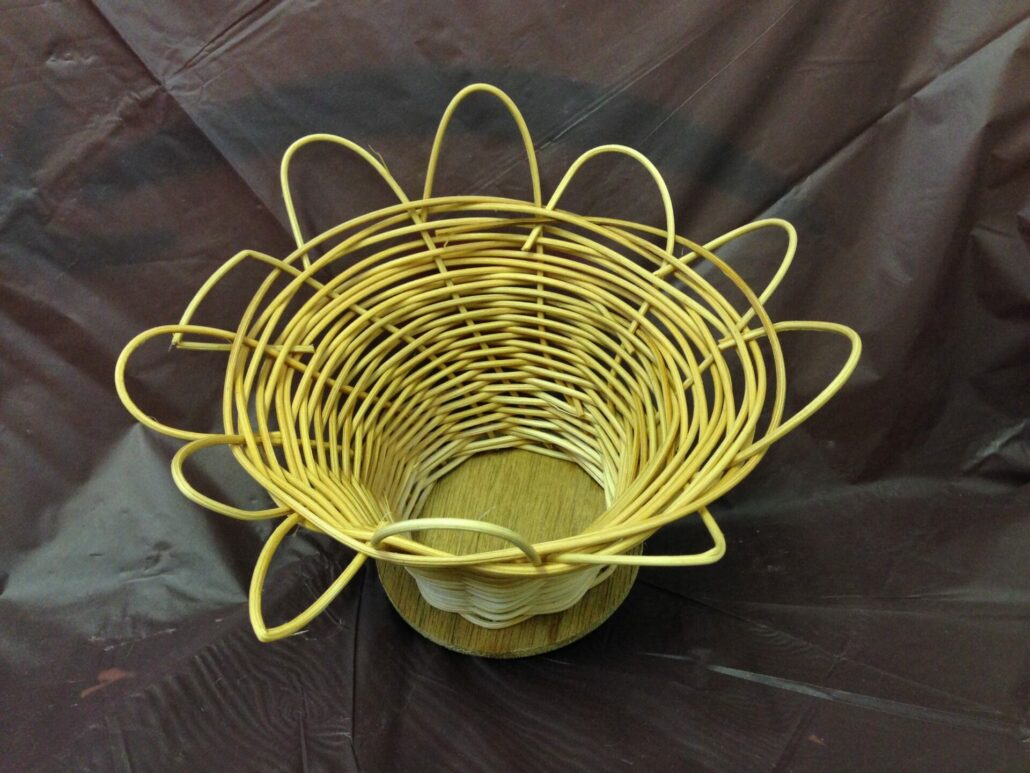
Although the basket weaving project took longer than I had anticipated – meaning we were unable to fit in the music class I had planned – overall the day went well and I was pleased with the flexibility of the open schedule.
Sample Day at Samson Home School Academy when HISD is in session
In an earlier post, I described a sample day when HISD was not in session. In this post, I describe a more typical day, one which includes HISD online classes.
Our day begins with a short session of aerobics followed by yoga. Students then settle into their desks to do timed multiplication drills before logging into their HISD classes or assignments. Students spend the morning alternating between online classes and HISD assignments and Samson classes and assignments.
Samson morning classes include typing, grammar, and writing. Samson assignments include cursive, memorization, and spelling. Students also receive individual lessons in math – done one-on-one at the white board – as well as in grammar, spelling, and writing.
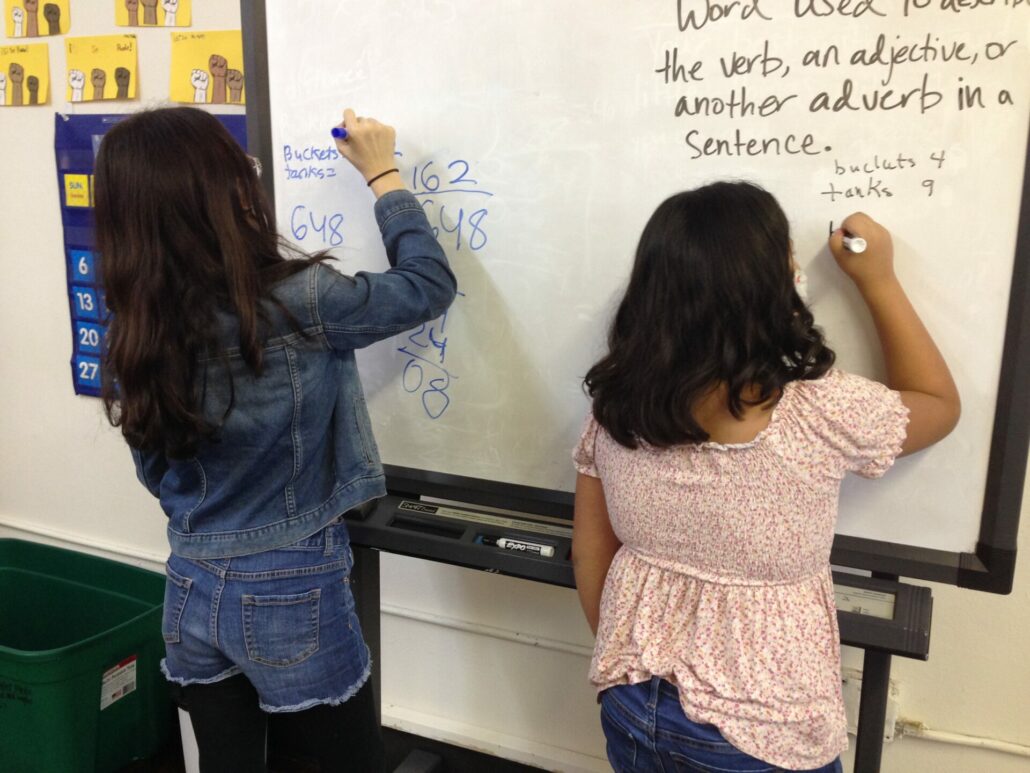
Free reading is available to those between assignments, or to provide a “brain break.”
After lunch, students participate in a short karate lesson outdoors. Once back inside, students practice skip counting songs. While some students go online for their final HISD class of the day, the others wrap up any unfinished assignments or work on their weaving.
Once all students are again available, they gather on the carpet to watch a biography of a famous composer, artist, or historical figure or a video outlining a historical event or an aspect of science. This is followed by a hands-on project to reinforce the material just covered. Students have made “magic flutes” while listening to Mozart or put together booklets on the different types of whales. They have learned to perform a haka after learning about Maori creation stories. They have colored coke cans à la Warhol and decorated sugar skulls for Day of the Dead.
In their most recent major project, they spent two weeks planning and constructing a city out of recycled materials. As students finish a unit of history, they add figures to their Book of the Centuries, a timeline of events and people that shaped the world.
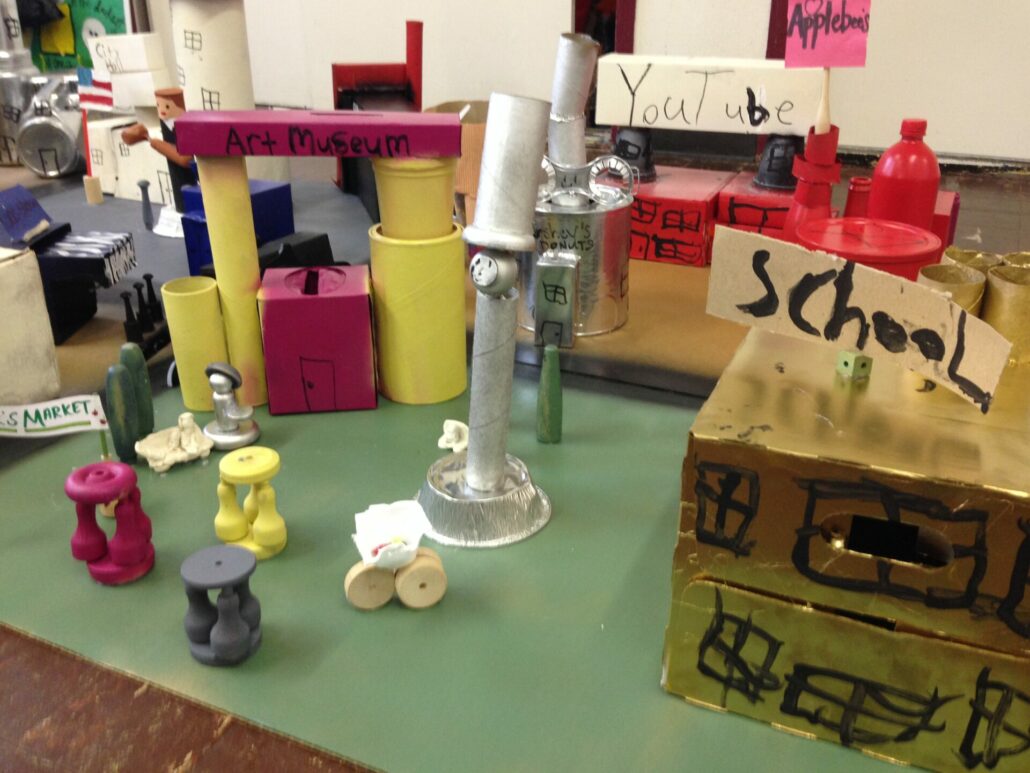
At the end of the day, students take turns with the various chores involved in cleaning the classroom before leaving for the day.
Our schedule takes into consideration student online commitments, as well as our own requirements for outdoor time, alternation between online work and handwritten assignments, and daily hands-on activities.
The New York Times of October 14, 2020, had an interesting article on the long-term effects of the pandemic on education. A number of micro-schools, learning pods, and other alternative forms of education have sprung up all over the country, many of which are expected to continue even once the virus has been brought under control.
The reasons for this are clear. “In a microschool, if you master things quickly, you move ahead quickly, but if you need more time, learning is slowed down so you can fill in the gaps, says Maureen O’Shaunghnessy, Ph.D., administrator of LEADprep, a Seattle microschool.
At Samson Home School Academy, this attention to the individual is part of the reason for its existence. Certainly it was part of why I homeschooled both my children. In a traditional classroom, with 25-30 students (and sometimes more!), it is extremely difficult for a teacher to give attention to an individual student. In addition, a significant portion of class time is given over to “crowd control,” and many activities that are possible in a micro-sized class are impossible even with a “small” class of 15-20 students. (Imagine for a moment, if you will, 25 kindergarteners, each with a bottle of Elmer’s glue and you’ll understand what I mean.)
With a micro-sized class, instruction can be tailored to the individual student. While one explanation may enlighten one student, another student may need a different approach in order have that all- important “light bulb” moment. In a micro-sized class, the teacher can see, and address, these kinds of differences.
In a micro-sized class, too, individual interests can be accommodated, even encouraged. My younger son, for example, used some of his homeschooling time to teach himself video filming and editing techniques. A graduate of UT’s film department, he now operates his own digital editing service.
In short, individual readiness, learning styles, and interests are best served in micro-sized environments. Small wonder, then, that one long-lasting effect of the pandemic may be the continued reliance on homeschooling and micro-schools.
